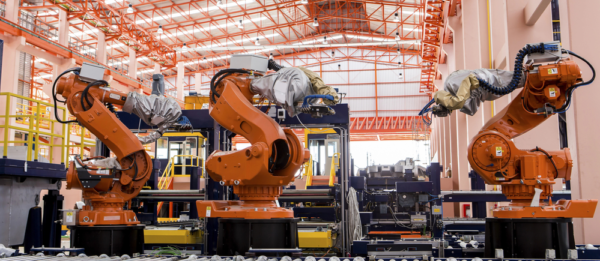
With more investment capital flooding into the Middle East region for automotive manufacturing, there are numerous opportunities for new companies to start up and for existing businesses to expand. However, to firmly establish your company as a reliable partner and attain consistent growth, you need to outperform the competition both in terms of product quality and price. Preventative maintenance is a powerful technology that can set your business apart. How can you implement preventative maintenance in your automotive manufacturing operations?
AI-Powered Predictive Maintenance in Automotive Manufacturing
The Economic Impact of Proper Maintenance
A recent Siemens report found that downtime costs the automotive industry roughly two million dollars per hour. Downtime is largely caused by faulty processes that cannot reliably produce components or perform operations with expected consistency. Maintenance, therefore, is vital to keeping operations running effectively. While nearly every industrial company has dedicated staff for maintenance and performs routine service on its equipment, they still struggle to minimize downtime. The root problem is their approach to maintenance.
Most companies take a traditional, reactive approach to maintenance. This approach resembles how we often care for our own vehicles. Maintenance adheres to recommended schedules based on equipment manufacturer’s guidelines. If a problem suddenly appears, the machine gets taken offline for service. Unfortunately, these latter scenarios produce the most downtime. A report from Plant Engineering noted that 20% of machine failures are responsible for 80% of downtime, and most of these are cases that slip past routine checkups.
Traditional Maintenance Methods Are Inefficient
Why do so many failures occur even with rigorous maintenance protocols? The issue at hand is that preventative maintenance can only hope to prevent problems, but it cannot identify when problems are more likely to occur. Performing predictive maintenance is like a doctor seeing a patient only periodically for routine checkups. Without more constant data about their behavior and wellbeing, doctors have no way of knowing if an illness is likely to develop between visits.
The same is true for your machinery. Periodic maintenance is good, but predictive maintenance is even better. A predictive approach requires a constant stream of data from your equipment to measure its performance. This data is then fed into intelligent systems that can determine whether the machine is operating correctly, or slowly drifting out of spec. By detecting deviations early, they can be addressed when it’s convenient for your operations, minimizing downtime and its impact.
Using AI to Learn Machine Patterns
Artificial intelligence and machine learning algorithms make it possible to interpret machine data and predict future failures. Consider how this might work for a hydraulic stamping press that fabricates auto parts. A preventative system would start by taking normal operating parameters to establish upper and lower limits for various data points. For example, you might measure hydraulic fluid temperature, applied pressure, or vibration within the machine. Output performance should also be measured.
Data will be collected at high frequencies, perhaps up to hundreds of times per second, and stored in a database. When the machine is working properly, these readings establish a baseline for performance. From there, AI will look for patterns in the data. It may notice, for instance, that the press has started to vibrate more heavily with readings that are trending towards the upper threshold. Programmed logic can then send notifications to maintenance crews in advance of a failure.
Collecting Data
Without data, predictions are impossible. Many modern machines have data output systems and sensors already built in, which can relay data to hubs or to a central server. However, older equipment may not have these features built in. Fortunately, you can retrofit older machines with sensors for pressure, temperature, vibration, and more. In fact, full retrokits exist for specific machine models using readily available off-the-shelf Internet of Things devices.
To avoid running a complex web of cables throughout your factory floor, the best approach is to install wireless hubs that use Wi-Fi or Bluetooth technology to relay information. Wires from sensors or from machine ports can be fed into these hubs. Next, the hub is programmed to relay information to a specific server. Many businesses send their data straight to the cloud, as it’s cheaper than operating expensive computer servers locally.
AI Processing in the Cloud
Cloud computing has made AI and machine learning much more accessible. Rather than spending thousands of dollars on expensive processors, your company can take advantage of another’s economies of scale. Amazon Web Services (AWS) or Microsoft’s Azure platforms, for example, provide distributed cloud storage and processing. You only pay for the actual processing power you use from their massive network of datacenters.
Your programs run in the cloud and can deliver data or notifications directly to specific individuals in your organization. It’s even possible to develop a custom interface for machine maintenance that includes data regarding the maintenance procedures to be performed using an Industrial Data Analytics Platform (IDAP). Best of all, predictive systems only become more accurate over time. Eventually, your system will be able to predict failures with far greater accuracy than your engineers.
Achieving a Digital Transformation
Predicting and preventing downtime isn’t just an industrial engineering problem. Downtime can plague your company in other departments as well. Whether it’s sluggish sales, inefficient resource allocation, or technical difficulties in the back office, you want your entire company to operate as effectively as possible. A complete digital transformation can take all of your business processes into the future through cloud technology and AI-powered analytics. Leaner, more efficient automotive companies will succeed where others fail.
Contact SAAB RDS to schedule a meeting with our Industry 4.0 experts to discuss your digital transformation.
